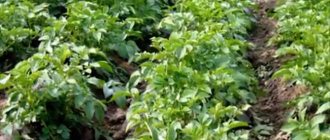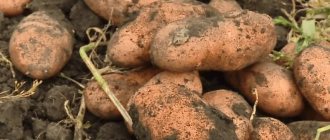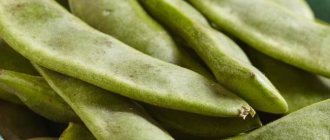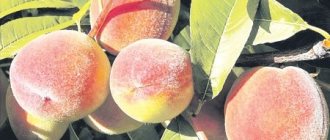Vegetable growing » Potatoes
1
1617
Article rating
Kira Stoletova
Potatoes are rightfully considered the most popular food product of all mankind. You can prepare a wide variety of dishes from it. People believe that this type of root vegetable is perfect for ridding the body of large amounts of water and salt accumulations. A fairly popular potato variety is the Skazka potato.
Characteristics of the Fairy Tale potato
Description of tubers
Harvest ripening occurs 70-90 days after planting. Medium-sized tubers - from 70 to 130 g. The shell is white. The flesh is the same shade. There are eyes of medium depth on the surface. Painted in a dark pink shade.
The percentage of starch content varies between 14-17%. Potatoes are universal, suitable for making soups, salads, frying and boiling. When peeled and heat treated, the pulp does not change its color.
basic information
These potatoes are commercial varieties.
general characteristics
Skazka is a mid-early variety with a growing season of 80-90 days . Has a table purpose. It is distinguished by a large number of tubers per bush (from 15 to 30). The productivity of Skazka does not depend on the size of the planting material. Small and large tubers have the same productivity.
Description of appearance
The plant is medium-sized.
- Escapes . The shoots are erect, grow up to 70-80 cm. The leaves are small in size and have a light green color. The stems are not spreading; in one bush there can be up to six of them.
- Root vegetables . The tubers are oval-shaped, covered with a light yellow skin. The eyes are small, not deep, and colored pink. The pulp is white.
Seeding rate and yield per 1 hectare
From 300 to 500 centners are collected from 1 hectare. Seeding rate – 3500 kg. Productivity depends on care. With minimal activities, about 20 tubers are obtained from the bush. With good care - up to 40.
Taste qualities
The taste properties of the variety are assessed as high. The tale is a little sweet, which makes it popular with children.
Chemical composition
Potatoes have a rich chemical composition . It includes:
- vitamins (A, B1, B2, B6, B9, C, E);
- phosphorus;
- magnesium;
- potassium;
- calcium;
- fluorine;
- iodine;
- zinc;
- chromium;
- iron;
- carbohydrates;
- proteins;
- fats;
- organic acids.
If potato dishes predominate in the diet, there will be no shortage of elements necessary for health.
Average tuber weight
The tubers grow of medium size, weighing 80-130 g.
Important!
If root crops do not receive enough nutrition, they may become small. This is explained by the fact that the variety is prone to producing a large number of tubers.
Marketability
The marketability of the variety is high. 85-88% of the total tubers are suitable for sale .
Resistance to diseases and pests
The fairy tale is resistant to viral diseases, scab and cancer. It has relative resistance to macrosporosis, alternaria and rhizoctonia. The variety is not resistant to pests without preventative treatment.
Keeping quality
The variety has good keeping quality, which is 90%. Root crops planted in the fall can be used for planting in the spring.
Where is it used?
The tale is used for frying, making purees, fries, first courses and baking. Boiled tubers do not disintegrate. When fried, the potatoes develop a crispy skin. The pulp retains its color after cutting and cooking .
In which regions of Russia is it usually grown?
The variety is recommended for cultivation in the Far Eastern, Ural and Middle Volga regions. Can grow on all types of soil. But it shows the highest yield on sandy loam, light loamy soils and peat bogs.
Advantages and disadvantages
The Skazka potato has a number of advantages. Among the main ones it is worth noting:
- High yields.
- Strong immunity that protects the crop from most fungal diseases.
- Easy to care for.
- Long shelf life.
- High commercial quality.
- Good taste.
At the same time, it also has its negative sides. Among them:
- The presence of relatively deep eyes, which makes cleaning the tubers much more difficult.
- A tall and spreading bush of tops makes it difficult to care for the crop.
Reviews from gardeners
Gardeners note that the variety is productive, the tubers are large and even. Shoots appear quickly, the plant is resistant to many diseases and is unpretentious in care. The boiliness is slight; the potatoes do not darken when boiled or cut.
Reviews say that the potatoes are smooth, easy to peel, and store well in winter. The fruits have excellent taste when boiled, fried, as well as in salads and other dishes.
The versatility of the variety allows it to be used by both small gardeners and large-scale plots. Potatoes are valued because of their high yield and suitability for long-term storage. It has a good taste, is suitable for transportation and shelf life, which allowed the variety to take its rightful place in the agricultural market.
Growing Tales
Preparations for planting begin in the fall, at the time of harvest. Then “elite” tubers are selected, which will later become planting material. Basic requirements for seed material:
- The tubers should be medium in size, about 60-70 cm. This is the standard. You can, of course, cut the potatoes into pieces, but experts recommend planting whole tubers.
- Root crops should not have any defects: rot on the surface, ulcers, insect tunnels, etc.
- 3-4 weeks before planting, it is advisable to remove the tubers from their storage location and germinate them.
The Skazka variety will produce the best yields in chernozems, sandy loam or loamy soils. It is ideal if crop rotation is observed and legumes, cabbage or cucumbers were previously grown on the planted area.
The site is being prepared in the fall. After harvesting, the soil is cleared of weeds. Then fertilizers (humus) are applied at the rate of half a bucket per 1 m2. After fertilizing, the soil is plowed/dug up.
Planting is carried out in early May, when the soil temperature rises to +8-9 degrees Celsius. The depth of planting potatoes depends on the type of soil on the site. If the soil is light sandy loam, then holes are made up to 10-15 cm. If the soil is heavy, then holes are dug no more than 5 cm.
The distance between the holes is maintained at least 25 cm, but preferably 30-40 cm. Row spacing is 60-70 cm. Such a large distance between rows is necessary for several reasons:
- Thanks to the large distance, the bushes will be ventilated and well lit.
- In the future it will be easier to hill up rows.
Potato fertilizer
Timely fertilizing is a way to increase the yield of vegetables. Feed the plants once every 10-15 days. The general rule for fertilizing is that it is applied to damp soil (after rain or good watering). The ideal option is to apply fertilizers before hilling.
At the beginning of the growing season, potatoes require fertilizing with nitrogen fertilizers to grow green mass. To do this, after sprouting, potatoes are fed with a mixture: 1 tablespoon of urea is dissolved in 10 liters of water. A bucket of this solution is poured onto 20 plants.
Before hilling, add a mixture: 1 liter of chicken manure is diluted in 10 liters of water and left for 24 hours. Only the roots of the plants are watered with this solution; after feeding the leaves, the mixture is washed off.
At the end of flowering, foliar fertilizing is done with phosphorus fertilizers: 1 kilogram of superphosphate per 100 liters of water. The mixture is sprayed over 100 square meters of area. Foliar fertilizing with phosphorus fertilizers increases yield and increases the starch content in tubers.
On a note:
Fertilizing with herbal infusion gives excellent results. To do this, fill a bucket of chopped green mass of weeds, grass or nettles with 20 buckets of water, add 1 liter of chicken manure and 0.5 liters of ash. The mixture is covered with a lid and left to ferment in the sun. A week after pouring, the infusion is ready for use.
Cultivation care
Caring for potatoes The fairy tale lies in hilling and irrigation.
Hilling up means moving soil from the rows to the crop bush. Additional stolons appear on the ridge formed by the soil, on which new tubers are formed. Thus, hilling not only helps to clear the garden of weeds and loosen the soil, but also increases the yield by 20-30%.
The first time potatoes are hilled 12-15 days after the first appearance of sprouts. By this time, the tops will have grown by 20-25 cm. The second hilling is carried out 3 weeks after the first.
The Skazka potato is a moisture-loving variety. But in any case, you should not neglect watering, since an abundance of water can only harm the future harvest.
Experienced experts recommend watering potatoes according to the following scheme:
- The first watering is carried out when the tops have become 10-12 cm. Earlier watering is not recommended.
- The second watering is when the inflorescences appear.
- The third is when they disappear.
Watering nuances:
- If climatic conditions are unfavorable (drought), then the amount of watering is increased.
- It is not recommended to water the bushes after flowering, since this period occurs at the peak of late blight activity, and moisture, as is known, is an ideal environment for its development.
Prevention
It is believed that this potato variety cannot be affected by diseases. But, preventive measures will never interfere with the path to a good harvest. Therefore, it is recommended to pay attention to the exact conditions in which the seed is stored. It is necessary that the air temperature is 10-12°C and the humidity is moderate.
We should not forget that you need to regularly spray the tops with special chemicals that will prevent the appearance of pests. Such preventive measures should be carried out before heavy watering. It is best to do this 2-3 days before installing the irrigation.
Sources:
https://sortoved.ru/kartofel/sort-kartofelya-skazka.html https://web-selo.ru/sort-kartofelya-skazka.html https://fermoved.ru/kartofel/skazka.html
Harvesting
Harvesting takes place in early autumn. A week before the planned harvest, the tops are mowed to protect the crop from the development of diseases and to allow the root crops to “ripen”.
Dug up tubers cannot be immediately placed in the cellar. They need to be dried for 5-6 hours in the fresh air. After drying, the tubers are sorted, removing damaged or infected tubers. After sorting, the potatoes can be transferred to a permanent storage location.
Immunity
The main diseases that the Skazka variety may encounter are:
- Late blight.
- L-virus.
- Rhizoctoniosis (black scab).
Late blight
When a crop is affected by this disease, yellowing of the leaves and the appearance of dark spots on the root crops are noted. An infected crop loses at least 10% of its total yield.
The main preventive measure is the selection of seed material.
L-virus
The first sign of this disease is curling of the leaves. The carrier of the disease is aphids.
We recommend reading: “Description of the Krasavchik potato variety”
Preventive measures include selecting high-quality seed material and destroying aphids.
Black scab
When this disease manifests itself, netted spots appear on the tubers, the stem becomes thin, and the plant begins to slow down in development. A crop affected by the disease loses from 10 to 40% of its yield.
The main preventive measure is compliance with crop rotation and selection of high-quality planting material.











